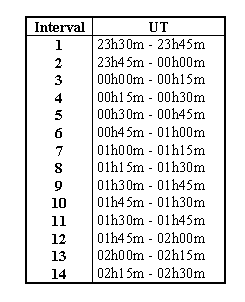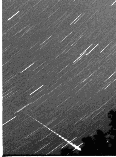The 1996 Perseid peak was observed by a team of 13 DMS observers near the village of Bad Nenndorf, Germany, after an unsuccesfull attempt to reach clear weather near the Polish border. Large clear spells were found near Hannover and we settled at location (9 24’ EL ; 52 19’.5 NL).

Observations started around 23h30m UT when activity was already high. Due to a bank of altocumulus clouds and the uncertainty in the corrections to be made for a partly covered field, the observations in the first hour are less accurate. All computations have been made in 15 minutes intervals.
A list of observers is given in table 2. Jaap van ‘t Leven did not take part in the expedition but he had a clear period at is home in Bosschenhoofd, Netherlands, which was located in the center of the great European depression. His observations were added to the set. In Bad Nennberg 12 observers did visual observations. Piet van Mil took care of the timings.
| Table 1: Observing periods | Table 2: Observers, T eff and numbers of observed meteors |
|---|---|
 |  |
In total 1493 Perseids and 346 sporadics were observed in 33.4 hours of net observing time. A large number of very bright meteors were observed between 1h and 1h30m UT when one -10, one -8, four -6 and at least 15 more smaller fireballs down to -2 illuminated our skies. After 0h30m UT the conditions were excellent with limiting magnitudes over 7.0 for several (young) observers.


Highest rates occured between 0h and 0h30m UT at the end of the rather cloudy period. Mean cloud coverage was about 25% during that period when ZHR values were stable around ZHR = 150. After 1h UT rates went down to a normal ZHR of about 50 at 2h30m UT when we stopped observations in heavy twilight.


Two mountings with a total of 14 Canon T-70 cameras with FD f/1.8-50 mm optics were operated between 0h15m and 2h40m UT. We expect to have photographed nearly all the bright fireballs. Additional we operated a f/4.5-160 mm spectrograph with a 465 l/mm grating which probably captured one of the brigh fireballs. A Honda power generator supplied electricity during the observations.
| 01:04:11 UT | 01:17:42 UT | 01:17:42 UT |
 |  |  |
| 01:28:28 UT | 02:08:40 UT |
 |  |
 |
Jaap van ‘t Leven photographed many bright fireballs and fainter meteors from
Bosschenhoofd. Also Jos Nijland in Benningbroek was succesfull. 5 Bright Perseids were captured on film, probably double station with Jaap van ‘t Leven. Left: Perseid -7, August 12, 1996; 01:04:10 UT Canon FD 1.8/50 mm, Kodak Tri-X J.A. van 't Leven, Bosschenhoofd, Netherlands This meteor is the multistation component of photo no. 1 from station Bad Nenndorf |
We are very gratefull to Visscher Electronics, Varsseveld who made it possible for us to communicate our data to the DMS webmaster from the remote area of Varsseveld. This report was made on august 13, 1996 by Hans Betlem and Guus Docters van Leeuwen.